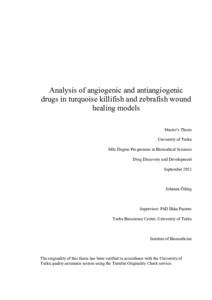Analysis of angiogenic and antiangiogenic drugs in turquoise killifish and zebrafish wound healing models
Örling, Johanna (2021-09-14)
Analysis of angiogenic and antiangiogenic drugs in turquoise killifish and zebrafish wound healing models
Örling, Johanna
(14.09.2021)
Julkaisu on tekijänoikeussäännösten alainen. Teosta voi lukea ja tulostaa henkilökohtaista käyttöä varten. Käyttö kaupallisiin tarkoituksiin on kielletty.
avoin
Julkaisun pysyvä osoite on:
https://urn.fi/URN:NBN:fi-fe2021101551162
https://urn.fi/URN:NBN:fi-fe2021101551162
Tiivistelmä
Impaired wound healing is an ever-increasing worldwide burden to human health affecting especially aged population. Wound healing is a complex process in which angiogenesis has a significant role. Recent data suggest that compounds having angiogenic effects could improve wound healing. The aim of this study was to investigate the effects of different angiogenic (roxadustat, tazarotene, deferoxamine, sodium nitroprusside and cobalt chloride) and antiangiogenic (semaxanib) compounds in zebrafish and turquoise killifish wound healing models. In addition, the purpose was to study the effects of aging on wound healing by comparing the regeneration of caudal fin between young and old fish. The results of the study showed that the regeneration of caudal fin in old zebrafish was significantly impaired when compared to young zebrafish. The inhibitory effect of semaxanib on fin regeneration was observed in both larval zebrafish and old turquoise killifish wound healing models. In turquoise killifish, this finding was also confirmed by qRT-PCR as lowered expression of cd34 and by histology as reduced amount of collagen in the regenerated caudal fin. However, the regeneration of caudal fin in larval zebrafish and old turquoise killifish was not improved after the treatment with angiogenic compounds. In conclusion, both aged zebrafish and aged turquoise killifish can be used to model wound healing during aging. However, no improvement on wound healing was observed with angiogenic compounds. Further investigation is needed in order to validate the fish wound healing models and to find novel treatments for wound healing.
